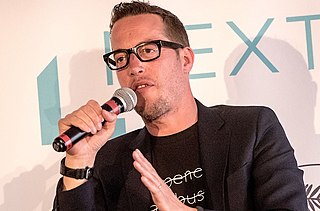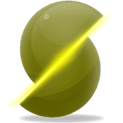
3D Systems, headquartered in Rock Hill, South Carolina, is a company that engineers, manufactures, and sells 3D printers, 3D printing materials, 3D scanners, and offers a 3D printing service. Chuck Hull, the CTO and former president, pioneered stereolithography and obtained a patent for the technology in 1986. The company creates product concept models, precision and functional prototypes, master patterns for tooling, as well as production parts for direct digital manufacturing. It uses proprietary processes to fabricate physical objects using input from computer-aided design and manufacturing software, or 3D scanning and 3D sculpting devices.

MakerBot Industries, LLC is an American desktop 3D printer manufacturer company headquartered in New York City. It was founded in January 2009 by Bre Pettis, Adam Mayer, and Zach "Hoeken" Smith to build on the early progress of the RepRap Project. It was acquired by Stratasys in June 2013. As of April 2016, MakerBot has sold over 100,000 desktop 3D printers worldwide. Since 2009, the company has released 6 generations of 3D printers, with the latest being the Replicator+ and Replicator Mini+. It was the leader of the desktop market with an important presence in the media but its market share is in decline. MakerBot also founded and operates Thingiverse, the largest online 3D printing community and file repository.

Martin Warner is a British technology entrepreneur, and film producer. He is best known as the chief executive officer and founder of botObjects, Flix Premiere and Autonomous Flight.

Thingiverse is a website dedicated to the sharing of user-created digital design files. Providing primarily free, open-source hardware designs licensed under the GNU General Public License or Creative Commons licenses, the site allows contributors to select a user license type for the designs that they share. 3D printers, laser cutters, milling machines and many other technologies can be used to physically create the files shared by the users on Thingiverse.

Open Source Ecology (OSE) is a network of farmers, engineers, architects and supporters, whose main goal is the eventual manufacturing of the Global Village Construction Set (GVCS). As described by Open Source Ecology "the GVCS is an open technological platform that allows for the easy fabrication of the 50 types of industrial machines that it takes to build a small civilization with modern comforts". Groups in Oberlin, Ohio, Pennsylvania, New York and California are developing blueprints, and building prototypes in order to test them on the Factor e Farm in rural Missouri. 3D-Print.com reports that OSE has been experimenting with RepRap 3-D printers, as suggested by academics for sustainable development.

Shapeways Holdings, Inc. is a Dutch-founded, New York-based 3D printing marketplace and service, publicly traded company. Users design and upload 3D printable files, and Shapeways prints the objects for them or others. Users can have objects printed in over 55 materials and finishes, these include: plastics, precious metals, steel and food-safe ceramics, which were discontinued and have been replaced by porcelain materials. As of 2019, Shapeways printed and sold more than ten million user-created objects.
MatterHackers is an Orange County-based company founded in 2012 that supplies 3D printing materials and tools. MatterHackers is developing their 3D printer control software, MatterControl.

Ultimaker is a 3D printer-manufacturing company based in the Netherlands, with offices and assembly line in the US. They make fused filament fabrication 3D printers, develop 3D printing software, and sell branded 3D printing materials. Their product line includes the Ultimaker S5 and S3, Ultimaker 3 series, Ultimaker 2+ series and Ultimaker Original+. These products are used by industries such as automotive, architecture, healthcare, education, and small scale manufacturing.

Fused filament fabrication (FFF), also known as fused deposition modeling, or called filament freeform fabrication, is a 3D printing process that uses a continuous filament of a thermoplastic material. Filament is fed from a large spool through a moving, heated printer extruder head, and is deposited on the growing work. The print head is moved under computer control to define the printed shape. Usually the head moves in two dimensions to deposit one horizontal plane, or layer, at a time; the work or the print head is then moved vertically by a small amount to begin a new layer. The speed of the extruder head may also be controlled to stop and start deposition and form an interrupted plane without stringing or dribbling between sections. "Fused filament fabrication" was coined by the members of the RepRap project to give an acronym (FFF) that would be legally unconstrained in its use.

EnvisionTEC is a privately held global company that develops, manufactures and sells more than 40 configurations of desktop and production 3D printers based on seven several distinct process technologies that build objects from digital design files. Founded in 2002, the company now has a corporate headquarters for North America, located in Dearborn, Mich., and International headquarters in Gladbeck, Germany. It also has a production facility in the Greater Los Angeles area, as well as additional facilities in Montreal, for materials research, in Kiev, Ukraine, for software development, and in Woburn, Mass, for robotic 3D printing research and development. Today, the company's 3D Printers are used for mass customized production and to manufacture finished goods, investment casting patterns, tooling, prototypes and more. EnvisionTEC serves a variety of medical, professional and industrial customers. EnvisionTEC has developed large customer niches in the jewelry, dental, hearing aid, medical device, biofabrication and animation industries. EnvisionTEC is one of the few 3D printer companies globally whose products are being used for real production of final end-use parts.

Slic3r is free software 3D slicing engine for 3D printers. It generates G-code from 3D CAD files. Once finished, an appropriate G-code file for the production of the 3D modeled part or object is sent to the 3D printer for the manufacturing of a physical object. As of 2013, about half of the 3D printers tested by Make Magazine supported Slic3r.

AstroPrint is a cloud platform and application marketplace designed for consumer 3D printing by 3DaGoGo Inc., a private San Diego based technology company.

InMoov is a humanoid robot, constructed out of 3D printable plastic body components, and controlled by Arduino microcontrollers.
ZYYX is a Swedish desktop 3D printer, designed primarily for office and educational applications. Originally launched in 2014 by Magicfirm Europe AB, based at Chalmers Innovation in Gothenburg, the ZYYX 3D Printer is based on FFF technology and features include an automated levelling function, smell-free operation and an extruder head which is less prone to jamming.

Cura is an open source slicing application for 3D printers. It was created by David Braam who was later employed by Ultimaker, a 3D printer manufacturing company, to maintain the software. Cura is available under LGPLv3 license. Cura was initially released under the open source Affero General Public License version 3, but on 28 September 2017 the license was changed to LGPLv3. This change allowed for more integration with third-party CAD applications. Development is hosted on GitHub. Ultimaker Cura is used by over one million users worldwide and handles 1.4 million print jobs per week. It is the preferred 3D printing software for Ultimaker 3D printers, but it can be used with other printers as well.

A variety of processes, equipment, and materials are used in the production of a three-dimensional object via additive manufacturing. 3D printing is also known as additive manufacturing, therefore the numerous available 3D printing process tend to be additive in nature with a few key differences in the technologies and the materials used in this process.
Marlin is open source firmware originally designed for RepRap project FDM 3D printers using the Arduino platform.
Markforged is an American public additive manufacturing company that designs, develops, and manufactures The Digital Forge — an industrial platform of 3D printers, software and materials that enables manufacturers to print parts at the point-of-need. The company is headquartered in Watertown, Massachusetts, in the Greater Boston Area. Markforged was founded by Gregory Mark and the chief technology officer (CTO) David Benhaim in 2013. It produced the first 3D printers capable of printing continuous carbon fiber reinforcement and utilizes a cloud architecture.















